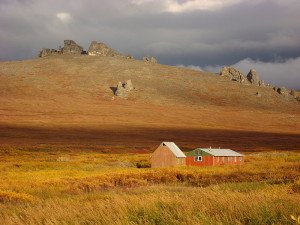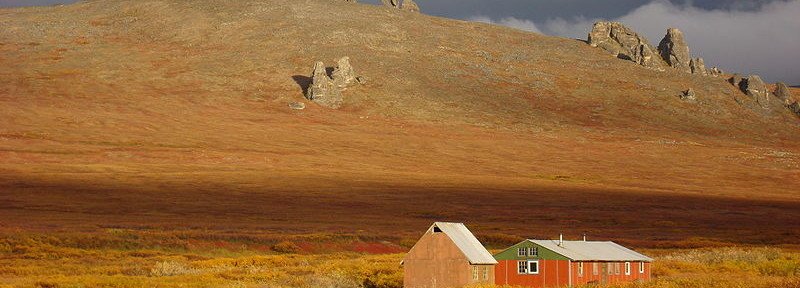Here on Alaska’s remote Seward Peninsula, the Bering Land Bridge National Preserve stands as a monument to the ancient migration of Asians to the North American continent. The people who made this migration about 13,000 years ago, eventually moved south and southeast and became the Native populations of North, Central and South America.
Thank you for reading this post, don't forget to subscribe!
Today, there is about 55 miles of water that separates Alaska from Siberia. This was once dry land. This land bridge, known as Beringia, was at one time 1,000 miles wide and allowed for this large ancient migration into the Americas. In the present day U.S., these peoples populated from the Pacific to the Atlantic.
It’s Remote / The Bering Land Bridge National Preserve
Bering Land Bridge National Preserve was established by the Alaska National Interest Lands Conservation Act on December 2, 1980.
The Bering Land Bridge National Preserve could be one of the most unique of all North American preserves. Here is just one example of this. The Natives of the area have the same traditions and language as do those living across the Bering Strait in Russia.

The Bering Land Bridge Nat’l Preserve offers visitors a total remote experience. The preserve is in the wilderness. No services or roads are available in this park.
According to the NPS, “backcountry campers can hike the rugged granite tors , glimpse raptors and waterfowl, explore ancient lava fields, and relax in the Serpentine Hot Springs” There is a bunkhouse near the Springs but understand that it is available on a first come, first serve basis. This National preserve offers a wild backcountry experience and could make a perfect adventure for someone looking for a completely new experience.
Wild Animals of the Seward Peninsula
Wild animals seen in the preserve include brown bears, muskox, caribou, reindeer, moose and beaver.
The muskox, once extinct in Alaska due to massive hunting, is a very interesting specie that has made an amazing engineered come back. At one time long ago, the prehistoric looking muskoxen roamed the now remote Alaskan tundra alongside the woolly mammoths. The males are known for their thick coats and the strong musky odor and are really more like goats and sheep rather than oxen. According to the Alaska Department of Fish and Game, the come back of this specie to Alaska was accomplished as follows….
“Muskoxen from Greenland were brought to the University of Alaska in Fairbanks in 1930, and a small group transplanted to Nunivak Island in 1935-36, where they have thrived. In 1970, thirty-six of the Nunivak Island animals were transplanted near the Feather River, 36 miles from Nome. A second transplant followed in 1981, with the release of thirty-five more animals at the Port Clarence Coast Guard Station, 15 miles west of Teller. The latest count of muskoxen on the Seward Peninsula shows their numbers approaching 3,000.”
Thanks to these translocations for cultural and economic reasons, the muskox herds appear to be thriving on the Seward Peninsula and in the Bering Land Bridge National Preserve.
Getting There
The Bering Land Bridge National Preserve, covering 2.7 million acres and over 4,200 square miles, is open year round. With that being said, flights into and out of the preserve are of course determined by the weather.
A visit to this preserve requires planning. During the summer season access is by bush plane, small boat or on foot. Only certain aircraft operators are permitted to land in the preserve. During the winter season access can be by bush planes on skis, snowmobiles or dog sleds. You will want to visit the Preserve’s Administrative Offices and Visitor Center in Nome.
Nome Alaska is not on the state’s highway system. Transportation to Nome is generally by commercial airline. There are no roads to the Bering Land Bridge National Preserve from Nome. Once you’re in Nome, getting to the preserve is only by the means listed above.
See the Trips Into History articles on the links below…
Pacific Coast Lighthouses / Point Pinos
The California Chinese and the Napa Valley Wine Caves
Two publications you may be interested in include…
Landcover Mapping for Bering Land Bridge National Preserve and Cape Krusenstern National Monument, Northwestern Alaska, published by the NPS.
Another is Trekking Across Beringer by author John Hemming.

Anybody planning a visit should bring with them all necessary food, supplies and equipment. Pack absolutely everything you’ll need.
The Bering Land Bridge National Preserve is a very unique National Preserve which can be a fun and educational historic trip for adventurist travelers. Hiking, camping, viewing the remote Alaskan wildlife and vegetation makes for a great time in one of the most remotest outposts on the North American continent.
(Article copyright Trips Into History. Photos are public domain and courtesy NPS)

